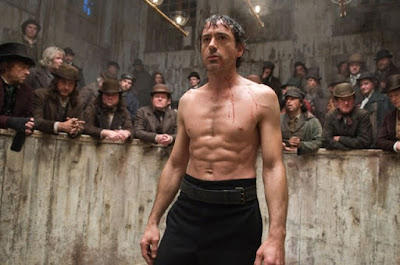The Mid Shot shows some of the subject in more detail while still showing the audience enough for them to feel they are looking at the whole subject, for example, if you are having a conversation with someone, their lower half is unnecessary and so that is not in shot.
Example:
In Guy Ritchie's 2009 film, "Sherlock Holmes", a mid shot is combined with a slight low angle shot to show how Holmes has just taken control of the situation, but that he is not in the clear yet.
Example:
In Guy Ritchie's 2009 film, "Sherlock Holmes", a mid shot is combined with a slight low angle shot to show how Holmes has just taken control of the situation, but that he is not in the clear yet.
Wide Shot:
A Shot in which the subject takes up the whole height of the shot, or at least as much as comfortably possible. Often used to establish a cast (see example) or create a sense of space within a shot.
Example:
Quentin Tarantino's "Reservoir Dogs" opening credits make use of a wide shot to comfortably and naturally (as well as stylishly) establish the main cast, before using close up shots to introduce each individual character.
Two-Shot:
A Two Shot is a shot which features two subjects. This shot type is often used in interviews.
Aerial Shot:
Aerial Shots are when the shot is taken from above the subject - often used to establish a location.
Example;
In the opening credits of one of my favourite films, Drive, the neon-bathed city of LA is established and introduced to the audience. This is where the viewer's experience begins and ends, and the city is almost a character in and of itself. This whole film is beautifully shot and I urge anyone reading to give it a watch, as it totally deserves your time.
POV Shot:
A POV shot is a shot in which it is shot from the character's perspective. Often used in horror films to show the victim running from the murderer, it can be used to build tension (in horror films) or to simply give the audience a closer, more personal look into a character's actions and life.
Example:
In Spielberg's classic "Jaws", a POV shot is used in a rather unorthodox way - shot from the point of view of a shark. This works incredibly well as as the "shark" approaches the lady swimming in the water, the audience knows the inevitable outcome of this shot is, while the swimmer is blissfully unaware of her impending doom. This POV shot, unlike a lot of slashers, employs dramatic irony to further fuel the sense of dread and tension that the audience feel. This iconic shot certainly cemented the film into the cinematic hall of fame.
Over The Shoulder Shot
This shot is framed from behind a person who is looking at the subject. The person facing the subject should usually occupy about 1/3 of the frame.This shot helps to establish the position of each person, and get the feel of looking at one person from the other's point of view.
Example:
In one of my favourite films from 2014, "The Guest", an Over The Shoulder Shot is used just before a fight breaks out. This is used effectively as it lets us know Luke's reaction to the unfolding situation, while building tension by keeping David in shot.
Example:
In one of my favourite films from 2014, "The Guest", an Over The Shoulder Shot is used just before a fight breaks out. This is used effectively as it lets us know Luke's reaction to the unfolding situation, while building tension by keeping David in shot.

No comments:
Post a Comment